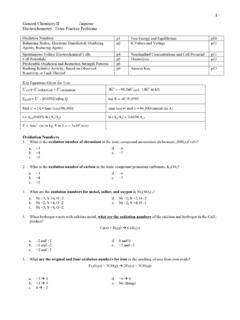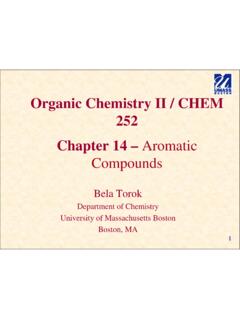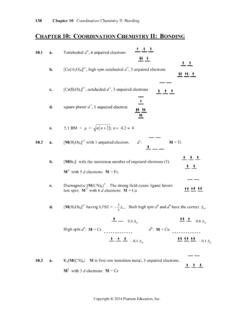Chemistry Ii
Found 8 free book(s)General Chemistry II Jasperse Electrochemistry. Extra ...
web.mnstate.eduGeneral Chemistry II Jasperse Electrochemistry. Extra Practice Problems Oxidation Numbers p1 Free Energy and Equilibrium p10 Balancing Redox; Electrons Transferred; Oxidizing Agents; Reducing Agents p2 K Values and Voltage p11 Spontaneous Voltaic Electrochemical Cells p4 Nonstandard Concentrations and Cell Potential p11
Organic Chemistry II / CHEM 252 Chapter 14 – Aromatic ...
alpha.chem.umb.eduOrganic Chemistry II / CHEM 252 ... Department of Chemistry University of Massachusetts Boston Boston, MA 1. Introduction 2 - Historical name, based on smell, no relation to sturcture • Nomenclature of Benzene Derivatives • Benzene is the parent name for …
Organic Chemistry II / CHEM 252 Chapter 20 – Amines
alpha.chem.umb.eduOrganic Chemistry II / CHEM 252 ... The lone pair of the nitrogen atom accounts for most chemistry of amines – The unshared electron pair can act as a base or as a nucleophile • The nitrogen lone pair can also make a carbon nucleophilic by resonance. 30 Reactions of Amines
General Chemistry II Jasperse Buffers/Titrations ...
web.mnstate.eduII. It can be prepared by combining a weak acid with a salt of its conjugate base. III. It can be prepared by combining a weak base with its conjugate acid. IV. The pH of a buffer solution does not change when the solution is diluted. V. A buffer solution resists changes in its pH when an acid or base is added to it. a. I, II, and IV d. I, II ...
CHAPTER 10: COORDINATION CHEMISTRY II: BONDING
www.chem.uci.edu10.8 Co(II) is d 7. In tetrahedral complexes, it is generally high spin and has 3 unpaired electrons; in In tetrahedral complexes, it is generally high spin and has 3 unpaired electrons; in octahedral complexes, it is also typically high spin and also has 3 unpaired electrons; in square
Laboratory manual Of PRACTICAL INORGANIC II CHEMISTRY
staff.uny.ac.idLaboratory Manual of Practical Inorganic II Chemistry RULES OF INORGANIC II LABORATORY WORK A. Laboratory work presence 1. Every student must come on time and fill the presence book. 2. Students, who come over than 15 minutes from the laboratory work schedule, may follow the laboratory work if only permitted by the lecturer. 3.
ISC SEMESTER 2 EXAMINATION SPECIMEN QUESTION PAPER ...
cisce.org(ii) Aniline and acetyl chloride Question 10 [2] Give one chemical test for each to distinguish between the following pairs of compound: (i) Acetaldehyde and benzaldehyde (ii) Acetone and acetic acid SECTION C – 12 MARKS Question 11 [3] (i) Answer the following: (a) Define molecularity of a reaction.
upsc.gov.in
upsc.gov.in(ii) : CH 1 NaH SiC1 Write down the products in the above reactions. OH H SO Conc. Eto- (ii) Complete the above reactions with mechanisms. 10 10 10 (i) SbC15 I IHNMR ? Write the structure of the reaction product between 3-chlorocyclopropene and SbC15. What is the unique feature of this product in 11-1 NMR spectrum ? HXS-B-CHM







